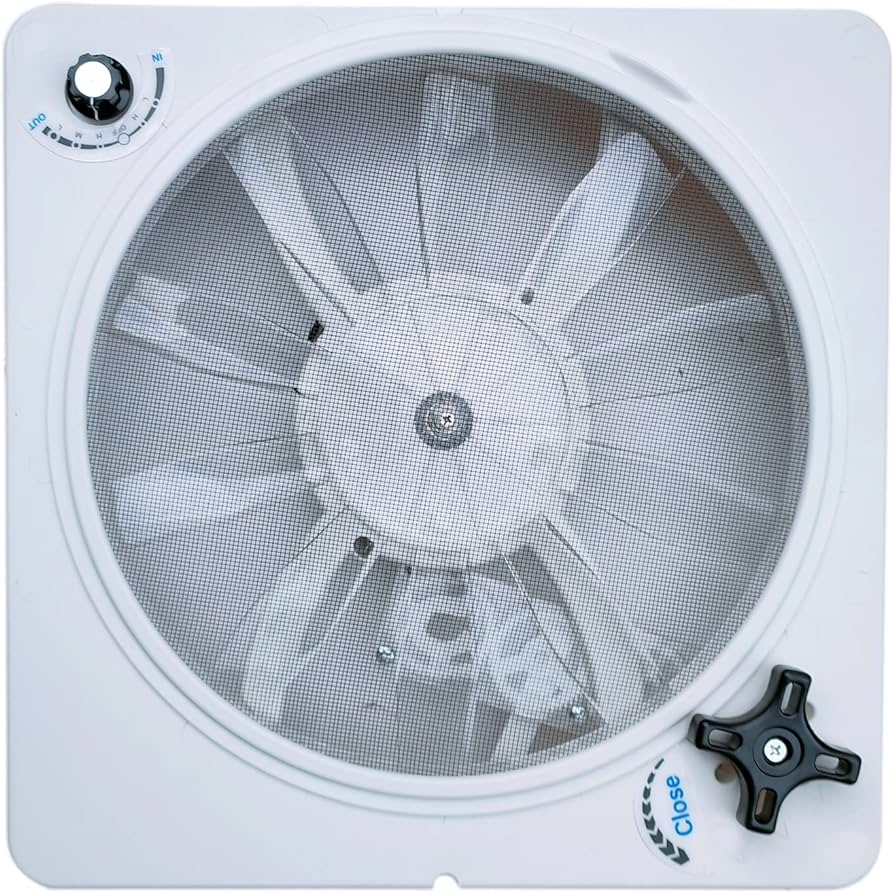To replace cracked RV vent covers, remove the old cover and measure its dimensions. Then, purchase a new cover with matching dimensions and attach it securely to the vent opening with self-tapping screws or the appropriate fasteners.
When it comes to maintaining your RV, ensuring that the vents are properly covered is essential for preventing damage and maintaining proper air circulation. Over time, the covers may become cracked and need replacement. This article will provide a guide on how to easily replace cracked RV vent covers, allowing you to keep your recreational vehicle in top condition.
With the right tools and steps, you can quickly replace the covers and protect your RV from potential issues caused by cracked vents. Let’s explore the steps to replace RV vent covers and keep your vehicle well-maintained for your next adventure.
Choosing The Right Replacement Vent Cover
When it comes to maintaining your RV, replacing cracked vent covers is essential for proper ventilation and preventing water damage. Choosing the right replacement vent cover involves considering your RV’s model and size, as well as selecting the correct material. Here’s what you need to know about selecting the right replacement vent cover for your RV.
Consider Your Rv’s Model And Size
Before purchasing a replacement vent cover, it’s crucial to consider your RV’s model and size. RVs come in various shapes and sizes, so it’s important to measure your existing vent cover to ensure the replacement fits properly. Refer to your RV’s manual or manufacturer’s specifications to determine the appropriate size for your vent cover. Taking accurate measurements will help you select a replacement cover that fits snugly and functions effectively.
Selecting The Correct Material
When selecting a replacement vent cover, it’s important to choose the correct material for your specific needs. Vent covers are typically available in various materials, such as plastic, metal, or polycarbonate. Each material offers different levels of durability, UV resistance, and insulation. Considering the climate and environment in which your RV operates can help in determining the most suitable material. For instance, if your RV is frequently exposed to harsh sunlight, a UV-resistant material may be preferable for longevity. Additionally, considering the weight of the material can ensure it’s compatible with your RV’s roof structure.
Preparing For Replacement
Replacing cracked RV vent covers is an essential task to ensure proper ventilation and prevent damage to your RV. Before you begin the replacement process, it is important to prepare yourself and gather the necessary tools and equipment. Additionally, taking the appropriate safety measures is crucial to avoid any accidents or injuries. In this section, we will discuss how to prepare for the replacement of RV vent covers, including gathering the necessary tools and equipment, as well as the safety measures you need to take.
Gathering Necessary Tools And Equipment
Before you start replacing the cracked RV vent cover, it is important to make sure you have all the necessary tools and equipment. Having everything on hand will help you complete the task smoothly and efficiently. Here is a list of the tools and equipment you will need:
| Tools | Equipment |
|---|---|
| Screwdriver | New RV vent cover |
| Pliers | Measuring tape |
| Utility knife | Caulking gun |
| Wire cutters | Screwdriver |
By having these tools and equipment ready, you will be well-prepared to effectively replace the cracked RV vent cover without any interruptions or delays.
Safety Measures To Take
When undertaking any home improvement task, safety should always be a top priority. Replacing RV vent covers is no exception. To ensure your safety throughout the process, keep the following safety measures in mind:
- Wear protective gloves and safety goggles to protect your hands and eyes from any debris or sharp edges.
- Make sure to turn off your RV’s power supply before starting the replacement to avoid any electrical accidents.
- Use caution when working at elevated heights. If you need to climb onto the roof of your RV, secure yourself with a harness or rope.
- Handle tools and equipment with care to avoid any injuries. Use them only for their intended purposes.
- If you are unsure or uncomfortable with any part of the replacement process, seek assistance from a professional.
Following these safety measures will help ensure a safe and accident-free RV vent cover replacement.
Removing The Old Vent Cover
Replacing cracked RV vent covers is essential for maintaining proper ventilation and preventing rainwater from seeping inside your recreational vehicle. The first step in this process is removing the old vent cover. Here’s how you can do it:
Identifying Attachment Mechanisms
Before you start removing the vent cover, it’s important to identify the type of attachment mechanisms used. Different RV vent covers have different mechanisms which may include screws, tabs, or clips. By identifying the attachment mechanism, you’ll be better prepared to remove the cover without causing any damage.
Carefully Detaching The Cover
Once you have identified the attachment mechanism, it’s time to carefully detach the old vent cover. Here are the steps to follow:
- Step 1: If the vent cover is held in place by screws, use a suitable screwdriver to remove them. Ensure you keep track of the screws, as you’ll need them to install the new vent cover.
- Step 2: For vent covers attached with tabs or clips, gently press the tabs or release the clips to loosen the grip. Be cautious not to apply too much force or use sharp objects that could damage the vent or the surrounding area.
- Step 3: Once the attachment mechanism is disengaged, carefully lift the old vent cover off the RV. Be mindful of any wiring or other components that may be attached to the cover. If necessary, disconnect them before completely removing the cover.
By following these steps, you can effectively remove the old vent cover without causing any unnecessary damage. Now, you’re ready to move on to the next step: installing the new vent cover. Stay tuned!

Credit: www.thriftydecorchick.com
Installing The New Vent Cover
To replace your cracked RV vent cover, start by removing the old cover and cleaning the area. Then, carefully measure the dimensions and choose a suitable replacement cover. Next, place the new cover over the vent and secure it in place.
Finally, test the functionality to ensure proper installation.
Proper Alignment And Positioning
When it comes to installing a new vent cover for your RV, proper alignment and positioning are crucial for optimal functionality. To ensure a proper fit, follow these steps:
- Before getting started, clean the area around the vent to remove any dust or debris that may interfere with its placement.
- Position the new vent cover over the existing vent opening, making sure it aligns with the screw holes or mounting brackets.
- Check that the new cover sits flush with the roof surface. If necessary, adjust its position to ensure a snug fit.
Securing The New Cover In Place
Once you have aligned and positioned the new vent cover, it’s time to secure it in place. Follow these steps to ensure a secure installation:
- Using the provided screws or mounting brackets, attach the new cover to the roof. Make sure to tighten the screws evenly, avoiding over-tightening.
- Double-check the alignment and positioning of the cover to ensure it hasn’t shifted during the installation process.
- Inspect the edges of the vent cover to ensure a tight seal against the roof surface. This will help prevent any water leaks or drafts.
- If necessary, apply a small amount of sealant around the edges of the vent cover to provide additional protection against moisture.
By following these steps, you can easily replace a cracked RV vent cover and ensure a secure and properly functioning ventilation system in your vehicle.
Maintenance Tips For Longevity
Regular maintenance is crucial to ensure the longevity of your RV vent covers. By following these simple tips, you can keep your vent covers in optimal condition for years to come.
Regular Cleaning And Inspection
To keep your RV vent covers performing their best, regular cleaning and inspection is essential. Dust, dirt, and debris can accumulate on the covers over time, hindering their functionality. Here are some steps to make cleaning a breeze:
- Remove the vent cover: Carefully unscrew or unlock the vent cover and gently lift it off the opening.
- Wash with mild soap and water: Mix a small amount of mild soap with water and use a soft cloth or sponge to clean the vent cover thoroughly. Avoid using abrasive cleaners or scrub brushes, as they can cause damage.
- Rinse and dry: Rinse the vent cover with clean water to remove any soap residue. Allow it to air dry completely before reinstalling.
- Inspect for cracks or damage: While cleaning, take the opportunity to inspect the vent cover closely. Look for any cracks, chips, or signs of wear and tear. If you spot any damage, it’s crucial to replace the cover promptly.
Protection Against Weather Elements
Your RV vent covers are constantly exposed to various weather elements that can cause damage over time. By taking precautionary measures, you can protect your vent covers from the harsh effects of the elements:
- Apply UV protectant: Exposure to sunlight and UV rays can cause the vent covers to fade or become brittle. Applying a UV protectant specifically designed for RV vent covers can help prevent these issues.
- Use vent covers for additional protection: Consider installing vent covers on the outside of your RV. These covers provide an extra layer of protection against rain, snow, and other weather elements, extending the lifespan of your vent covers.
- Keep tree branches trimmed: Overhanging tree branches can scrape and damage your vent covers. Regularly trim any branches that come into contact with your RV to prevent unnecessary wear and tear.
- Use a cover when storing: When your RV is not in use, consider using a protective cover that shields the entire vehicle. This will not only protect your vent covers but also keep your RV in excellent condition overall.
By incorporating these maintenance tips into your routine, you can ensure that your RV vent covers remain crack-free and functioning optimally. Don’t neglect the importance of regular cleaning, inspection, and protection against the elements – these simple steps can go a long way in prolonging the lifespan of your RV vent covers.

Credit: www.amazon.com

Credit: www.campingworld.com
Frequently Asked Questions Of How To Replace Rv Vent Covers That Are Cracked
How Can I Replace Cracked Rv Vent Covers?
To replace cracked RV vent covers, start by removing the screws securing the damaged cover. Carefully take off the old cover and clean the area. Place the new cover in position and reattach it using the screws. Make sure to align it properly for a snug fit.
Where Can I Buy Rv Vent Covers?
You can buy RV vent covers at various places, including hardware stores, RV dealerships, and online retailers. Look for covers that are compatible with your specific RV model and size requirements. It’s recommended to do your research and compare prices before making a purchase.
What Are The Benefits Of Replacing Cracked Rv Vent Covers?
Replacing cracked RV vent covers is important for several reasons. Firstly, it helps to maintain adequate airflow in your RV, preventing moisture buildup and unpleasant odors. Secondly, it protects your interior from rain, debris, and insects. Lastly, it improves the overall aesthetics of your RV, ensuring a clean and well-maintained appearance.
Conclusion
Replacing cracked RV vent covers is a crucial maintenance task that ensures proper ventilation and protects against damage. By carefully following the steps outlined in this guide, you can easily replace your RV vent covers and maintain the optimal functionality of your vehicle.
Remember, regular inspections and timely replacements will extend the life of your vent covers and prevent any potential issues down the road. Happy camping!


